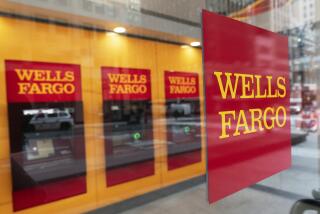It’s been a year since the Wells Fargo scandal broke — and new problems are still surfacing
One year ago today, Wells Fargo & Co. made the stunning admission in a settlement with regulators that it created perhaps 2 million accounts for customers without their permission.
The disclosure ignited a scandal that led in a matter of weeks to the ouster of its chairman and chief executive, John Stumpf, and to a host of promised reforms, including the removal of onerous sales goals that were widely acknowledged to be the source of the problem.
But a year later, the scandal that started with outrage over sham accounts has ballooned and that sin is just one of many the San Francisco bank has either copped to or been accused of.
An internal bank report reviewed by The Times shows that list could grow further still.
The report, produced for a risk-management committee that monitors Wells Fargo’s community bank — the business unit at the center of the accounts scandal — identifies several so-far undisclosed issues, all classified as “high risk.” They include improper fees charged on some accounts that were closed when the holders either died or were declared legally incompetent, a practice that dates to at least early last year.
Coupled with some of the bank’s recent admissions — including an audit that found the number of sham accounts may total 3.5 million — the report shows how the bank continues to uncover bad practices that previously went undetected or unaddressed.
“It keeps expanding,” said bank analyst Bert Ely. “The question one has to ask is, when does the last shoe drop? Or are there more to drop? Anyone who looks at this continues to be astounded at how problems from the past keep coming up.”
On Sept. 8, 2016, Wells Fargo admitted to the fake-accounts fiasco and agreed to pay $185 million in fines and penalties to regulators, including the Los Angeles city attorney’s office. The bank’s practices were first uncovered by a 2013 Los Angeles Times investigation, which led to a 2015 lawsuit from City Atty. Mike Feuer.
Since then, though, the bank has acknowledged additional bad practices and is facing investigations and lawsuits over many more — and not just within the community banking division.
In July, the bank said it would pay $80 million in refunds to hundreds of thousands of auto-loan borrowers who were forced to pay for bank-purchased auto insurance policies despite having coverage of their own.
In an August regulatory filing, the bank reported that the Consumer Financial Protection Bureau is investigating two separate matters, including allegations that the bank improperly charged fees to mortgage borrowers when loan applications were delayed — a practice also alleged in two recent lawsuits.
Other suits filed over the last year allege a bevvy of additional problems, including improperly changing the terms of mortgage loans for bankrupt borrowers, signing up customers for unauthorized life insurance policies and overcharging small businesses for credit- and debit-card processing services.
Some of the latest issues to surface, most notably the auto insurance matter, are the result of the bank’s own review of practices and consumer complaints.
Mary Mack — who replaced Carrie Tolstedt, the former head of the community bank who was fired last year — said Wells Fargo is dedicating more resources to analyzing, investigating and correcting potential problems.
“We want to escalate [issues] quickly so we can get the right eyes and support and help on potential issues,” she said.
She acknowledged that new admissions or allegations weigh on morale at the bank, but said that’s to be expected and that the bank cannot identify or fix everything overnight.
“All the evolution we’re engaged in takes time,” Mack said. “It is hard for the team to read negative headlines, particularly since the headlines may not be capturing the full essence of the story behind it, but that’s part of the process we’re in right now.”
Current and former Wells Fargo employees say bank executives did not take complaints seriously enough before the scandal, preferring to deal with them one by one and failing to look into the root causes of repeated issues.
An employee in the bank’s risk-management division said all of that has changed dramatically in the last year.
“When issues like this are popping up, the bank is doing a better job of acting and reacting to it,” said the employee, who spoke on the condition of anonymity. “A couple years ago, they never would have taken this kind of action to figure out who was affected by a problem and how far back it goes. Nobody was looking and saying, ‘What really caused that fee to be assessed?’”
Scott Siefers, an analyst with investment bank Sander O’Neill, said it’s good that the bank appears to be taking problems more seriously — but at the same time, it all but ensures there’s more bad news ahead.
A bank the size of Wells Fargo, which has more than 250,000 employees and boasts that it does business with 1 in 3 American households, is bound to uncover problems if it goes out looking for them, he said. And the more it finds, the more it paints a picture of a bank that is or was out of control.
“The problem with being such a broad and deep company is if you turn over enough rocks, you’re going to find some things,” Siefers said.
The internal report, published in July, lists five high-risk issues, all identified by the bank itself.
Wells Fargo officials, including Mack and Vic Albrecht, risk officer for the community bank, declined to comment on the report. Albrecht did say, though, that issues categorized as “high risk” in reports to the community bank’s risk committee would generally include those that might be widespread, affect customers or have regulatory ramifications.
“‘High-risk’ does not mean on-par with the sales practices issue,” he said, noting that the issue of unauthorized accounts is instead categorized by the bank as “critical,” a higher risk level.
The issue of early withdrawal penalties for deceased or legally incompetent account holders was identified last September, and is a violation of bank policies and federal regulations, according to the report.
The report notes that Wells Fargo’s systems are supposed to ensure fees are waived in those cases. The report does not suggest how widespread the problem might be or how far back it might go but nevertheless identifies it as a “potential UDAAP concern” — a reference to consumer protection laws that ban unfair, deceptive or abusive acts or practices.
Another issue mentioned in the report, identified in November, has to do with fees paid by business account holders when they deposit cash. The report provides much less information about this issue, calling it “confidential” and subject to attorney-client privilege.
For both of those issues, the report suggests the bank will offer some kind of remediation to affected customers.
Other matters identified as high risk are problems with how errors are reported at the branch level, a lack of proper notification when calls to customers are being recorded and problems with how stop-payments are processed, resulting in refunds to customers going unclaimed.
Siefers, who has not seen the internal report, said these issues don’t appear to rise to the level of some of the bank’s other admissions but that more findings will nevertheless wear on investors.
“None of this is good news,” he said.
Though Wells Fargo has continued to earn billions in profits, the scandal has taken a toll. The bank has paid or agreed to pay at least $414 million in refunds and settlements, and hundreds of millions more on legal fees, consultants and other costs related to the accounts scandal and its aftermath.
Meanwhile, the bank has continued to grow, but at a slower pace with new account openings down significantly through the second quarter of this year. For instance, the bank reported opening 395,000 new credit card accounts during the quarter — a decline of 42% from the same period last year.
And the bank’s stock has suffered. It declined sharply in the weeks after the scandal broke and, despite a recovery, has continued to underperform compared to its peers.
Since Sept. 7 of last year, the day before the scandal broke, Wells Fargo shares are up just 3%. The KBW Nasdaq Bank Index, a benchmark for the banking industry, is up 27% over that period.
If more problems continue to leak out, Siefers said investors will eventually get fatigued.
“You get to clear the decks for a period of time and look retrospectively,” he said. “But there is a point at which investors and analysts would say, ‘You just keep finding these things, and it feels like this is just what the company is.’ If we’re still having conversations like this a year from now, that will be a problem.”
Follow me: @jrkoren
ALSO
California Legislature approves arbitration measure spurred by the Wells Fargo scandal
Even as Wells Fargo scandal deepens, GOP lawmakers push bank deregulation
Former Wells Fargo executives say they were scapegoated for accounts scandal
More to Read
Inside the business of entertainment
The Wide Shot brings you news, analysis and insights on everything from streaming wars to production — and what it all means for the future.
You may occasionally receive promotional content from the Los Angeles Times.











